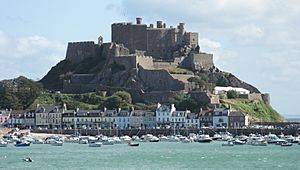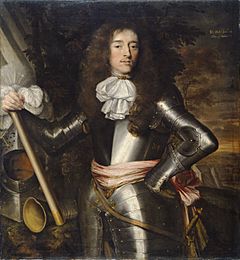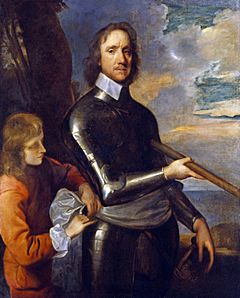Hardress Waller facts for kids
Quick facts for kids
Sir
Hardress Waller
|
|
|---|---|

Mont Orgueil, where Waller died in 1666
|
|
| Member of the Protectorate Parliament for County Clare, County Limerick and County Kerry |
|
| In office 1654–1659 |
|
| Governor of Limerick | |
| In office 1651–1653 |
|
| Member of the Irish Parliament for County Limerick |
|
| In office March 1639 – January 1649 (did not sit after 1640, formally dissolved by the death of Charles I) |
|
| Member of the Irish Parliament for Askeaton |
|
| In office July 1634 – April 1635 |
|
| Personal details | |
| Born | c. 1604 Chartham, Kent |
| Died | 30 July 1666 (aged 61) Mont Orgueil, Jersey |
| Nationality | English |
| Spouse | Elizabeth Dowdall (1629–1658) |
| Children | Walter (1632?-1658/1659?); James (1636–1702); Bridget (1639-1721); Anne (1641–1709); Mary; Elizabeth (1637–1708) |
| Occupation | Radical politician and soldier |
| Military service | |
| Years of service | 1625–1652 |
| Rank | Major General |
| Battles/wars | Anglo-Spanish War (1625–1630) Cádiz expedition (1625) Irish Confederate Wars Siege of Carlow; Limerick Wars of the Three Kingdoms Naseby; Langport; Bristol; Basing House; Siege of Exeter |
Sir Hardress Waller (around 1604 – 1666) was an English Protestant who moved to Ireland. He was a soldier and politician. He fought for the Parliament in the Wars of the Three Kingdoms. He was a key member of the New Model Army. He signed the document that led to the execution of King Charles I in 1649. After Charles II became king in 1660, Waller was sentenced to life in prison for his role in the king's death. He died in prison.
Contents
Early Life and Family
Hardress Waller was likely born around 1604. He was the only son of George Waller and Mary Hardress. Both of his parents passed away by 1622. His father sold the family's main lands in 1601. After that, they lived on his mother's property in Chartham, where Hardress probably grew up. His first cousin was Sir William Waller, another important general for Parliament.
In 1629, Hardress Waller married Elizabeth Dowdall. She was the daughter of Sir Thomas Southwell. Sir Thomas was an English settler who owned a lot of land in County Limerick, Ireland. Through this marriage, Waller gained a large estate in Castletown.
Hardress and Elizabeth had two sons, Walter and James. They also had four daughters: Elizabeth, Bridget, Anne, and Mary. All of his daughters married important people. For example, Anne married Sir Henry Ingoldsby, a relative of Oliver Cromwell. These family connections helped the Wallers keep their lands in Castletown. They remained an important family in the Munster region of Ireland for many years.
Early Military and Political Career
Not much is known about Waller's very early career. In 1625, he joined a military unit for the Anglo-Spanish War (1625–1630). This unit was supposed to attack Cádiz in Spain. However, the ships carrying his unit were forced to land in Ireland and never reached Spain.
Waller was knighted in 1629. After his marriage, he settled in Ireland. He became a member of the Parliament of Ireland. He represented Askeaton in 1634 and County Limerick in 1639.
Waller was a strong opponent of Thomas Wentworth, 1st Earl of Strafford. Strafford was the Lord Deputy of Ireland from 1632 to 1640. In 1640, the Irish Parliament chose Waller to deliver a formal complaint against Strafford to the English Parliament. Some of these complaints were used in the charges that led to Strafford's execution in 1641.

The Irish Rebellion and English Civil War
In 1641, the Irish Rebellion of 1641 began. Waller was trapped in his castle at Castletown in March 1642. He had to surrender six weeks later because he ran out of water. He later said he lost property worth over £11,000.
Waller was made a lieutenant colonel in the army that was trying to stop the rebellion. He also joined the Protestant war council in Munster. But the First English Civil War started in England in August 1642. This stopped the flow of soldiers and money from England to Ireland.
In September 1643, King Charles I agreed to a truce with the Catholic Confederacy in Ireland. The king wanted to use his Irish soldiers to help him win the war in England. Waller did not agree with this truce. He joined the Parliamentarian side instead.
In April 1645, Waller was made a colonel in the New Model Army. He fought in many important battles in 1645 and 1646. These included the Battle of Naseby, Langport, and the Siege of Bristol. He was wounded during the Siege of Basing House. When King Charles surrendered in April 1646, Waller was part of the army besieging Exeter.
Political Changes and Later Life
Waller's cousin, Sir William, was a moderate Presbyterian. However, Hardress Waller became a religious Independent and admired Oliver Cromwell. He moved back to Ireland in February 1647. But he disagreed with Inchiquin and returned to England. There, he became more involved in radical politics. He took part in the Putney Debates, which were important discussions about England's future.

During the Second English Civil War in 1648, Waller was a Parliamentarian commander. He successfully stopped several local revolts in the West Country. Soldiers from his regiment helped remove moderate Members of Parliament in December 1648. Waller was also one of the 59 judges who signed the death warrant for King Charles I in January 1649. He was the only Irish Protestant to do so. Many other Protestants, including Inchiquin, were against it.
In December 1649, Waller finally joined Cromwell in Ireland. Cromwell returned to England in May 1650. Waller was promoted to Major General in June. He captured Carlow Castle in July. He was made Governor of Limerick after it surrendered in October 1651. This ended most of the major fighting, though some smaller battles continued until 1653.
Under the Protectorate, Waller had a lot of political power. His son-in-law, Sir Henry Ingoldsby, replaced him as Governor of Limerick in 1653. Waller and Ingoldsby were Members of Parliament for County Clare, County Limerick, and County Kerry in the Protectorate Parliaments.
However, Waller's strong loyalty to Cromwell and his role in the king's death made him stand out from other Irish Protestants. Most of them either disliked the Commonwealth or were suspicious of Cromwell. After Richard Cromwell resigned in 1659, Waller opposed the return of the monarchy. In February 1660, he tried to stage a coup in Limerick to prevent Charles II from becoming king. This attempt was quickly stopped. It was the last military action of the Wars of the Three Kingdoms in Ireland.
Waller was sent to England as a prisoner. He managed to escape to France. He then returned to London, hoping to benefit from a law that offered forgiveness for past actions. He was one of only two people involved in the king's death to plead guilty. He claimed he was appointed to the trial without his knowledge. He was sentenced to death, but his sentence was changed to life in prison. He was also allowed to keep his lands. He was imprisoned in Mont Orgueil on the island of Jersey, where he died in 1666.
Sources

